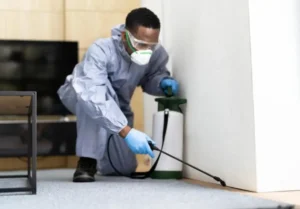Cockroaches are one of the most persistent pest problems facing Norfolk residents and businesses. These resilient insects adapt quickly to changing conditions and reproduce at alarming rates. Knowing about their behavior and effective control methods helps property owners combat infestations successfully.
Norfolk’s Cockroach Species
Several cockroach species infest Norfolk properties, each with distinct habits and preferences. German cockroaches, the smallest and most prolific species, favor warm, moist areas near food sources. They hide in kitchens and bathrooms, clustering around appliances, cabinets, and plumbing fixtures. A single female German cockroach can produce thousands of offspring annually.
American cockroaches, the largest common species, often enter buildings from sewers and storm drains. They prefer basements, crawl spaces, and other damp areas but will venture into living spaces searching for food. Their ability to fly short distances allows them to access upper floors and unexpected locations.
Oriental cockroaches thrive in cool, damp environments. They commonly inhabit crawl spaces, basements, and areas with plumbing leaks. These slow-moving insects emit distinctive musty odors that indicate their presence even before visible sightings occur.
Signs of Cockroach Infestation
Early detection improves treatment success rates significantly. Cockroach droppings resemble black pepper or coffee grounds, appearing in areas where roaches travel and feed. Larger species leave cylindrical droppings with ridges along the sides.
Egg cases, called oothecae, indicate active breeding populations. German cockroach egg cases are small, brown, and ridged, often found glued in protected areas. American cockroach egg cases are larger and reddish-brown, deposited in hidden locations near food and water sources.
Smear marks appear along walls and surfaces where cockroaches regularly travel. These dark, irregular marks result from roaches brushing against surfaces as they move along. In heavy infestations, distinctive musty odors permeate affected areas.
Live cockroach sightings during daylight hours suggest large populations. These nocturnal insects typically hide during the day, emerging only when overcrowding forces them into the open or when food scarcity drives daytime foraging.
Prevention Strategies for Homeowners
Sanitation practices form the foundation of cockroach prevention. Storing food in sealed containers eliminates easy meal sources. Cleaning up crumbs and spills immediately removes attractions that draw roaches into living spaces. Washing dishes promptly rather than leaving them overnight denies roaches water and food residues.
Reducing clutter eliminates hiding places that roaches need for daytime harborage. Cardboard boxes, stacks of newspapers, and accumulated items provide ideal shelter. Organizing storage areas and discarding unnecessary items makes spaces less hospitable to cockroaches.
Moisture control proves essential in deterring roaches. Fixing leaky faucets, pipes, and drains removes water sources that roaches require. Running exhaust fans during and after showers reduces bathroom humidity. Addressing drainage problems in crawl spaces and basements creates drier conditions that roaches avoid.
Exclusion work prevents roaches from entering buildings. Sealing cracks and crevices in walls, floors, and foundations blocks entry routes. Installing door sweeps closes gaps under exterior doors. Caulking around plumbing penetrations stops roaches from traveling through walls. Repairing torn window screens prevents flying species from entering.
DIY Treatment Limitations
Store-bought pesticides often fail to eliminate cockroach infestations despite aggressive application. Roaches develop resistance to common insecticides, rendering many products ineffective. Surface sprays kill only roaches that directly contact treated areas, missing the majority of the population hiding in walls and voids.
Cockroaches reproduce faster than most DIY treatments can kill them. A few surviving roaches quickly rebuild populations. Missing egg cases during treatment leads to new infestations as nymphs hatch and mature.
Improper pesticide application creates health hazards for occupants. Overusing products or applying them in food preparation areas risks contaminating surfaces and causing illness. Mixing incompatible products produces dangerous chemical reactions.
Professional Roach Extermination Methods
Licensed technicians employ integrated pest management strategies that combine multiple control tactics. Thorough inspections identify infestation sources, harborage areas, and conditions supporting roach populations. This information guides customized treatment plans addressing specific property conditions.
Gel baits provide highly effective roach control with minimal exposure risks. Technicians place small bait dots in cracks, crevices, and other areas where roaches travel. Worker roaches consume bait and return to harborage areas, where they die and other roaches feed on their remains, spreading the poison throughout the colony.
Dust formulations reach deep into wall voids, electrical outlets, and other inaccessible areas where sprays cannot penetrate. These long-lasting treatments continue killing roaches for months after application. Proper equipment ensures dust reaches target areas without creating visible residues or airborne particles.
Insect growth regulators disrupt roach reproduction by preventing nymphs from maturing into breeding adults. These products reduce populations gradually while other treatments eliminate existing adults. The combination provides long-term control.
Growth regulator baits combine attractants with chemicals that sterilize roaches or prevent egg development. These specialized products target breeding populations, preventing infestations from regenerating after treatment.
Treatment Process & Timeline
Initial treatments focus on quick knockdown of visible populations while establishing long-term control measures. Technicians apply multiple products using different modes of action to maximize effectiveness against resistant roach strains.
Follow-up visits assess treatment effectiveness and address any remaining activity. Roach populations rarely disappear after single treatments. Multiple visits ensure complete elimination as eggs hatch and hidden roaches emerge.
Most residential infestations require four to six weeks for complete elimination. Commercial properties with heavy infestations may need longer treatment periods. Patience and cooperation with treatment recommendations produce the best results.
Maintaining Roach-Free Properties
Ongoing monitoring catches new infestations early. Sticky traps placed in key locations detect roach activity before populations expand. Regular inspections identify conditions that might attract roaches.
Periodic maintenance treatments prevent reinfestation. Quarterly service visits maintain protective barriers and address any pest pressure from neighboring properties. Consistent pest management proves more cost-effective than repeated emergency treatments.
Conclusion
Roach extermination in Norfolk requires knowing about local species, implementing prevention strategies, and employing professional treatment methods when needed. While DIY efforts help reduce roach attractants, established infestations demand professional expertise and specialized products. Combining prevention, professional treatment, and ongoing maintenance creates roach-free environments that protect health and property value.



